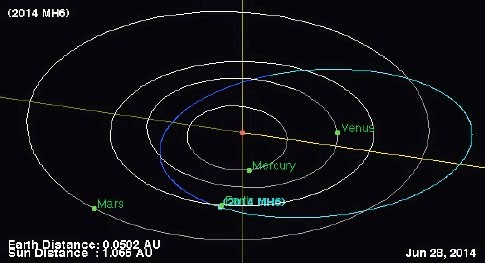Asteroid 2014 MY17 passed by the Earth at a distance of about 13 500 000 km (35.14 times the average distance between the Earth and the Moon), at about 3.25 am GMT on Thursday 26 June 2014. There was no danger of the asteroid hitting us, though were it to do so it would have presented a genuine threat. 2014 MY17 has an estimated equivalent diameter of 71-230 m (i.e. it is estimated that a spherical object with the same volume would be 71-230 m in diameter), and an object towards the upper end of this range would be predicted to be capable of passing through the Earth's atmosphere relatively intact, impacting the ground with an energy equivalent to about 500 megatons of TNT (roughly 30 000 times the energy of the Hiroshima bomb). Such an event would result in a crater about 2.5 km across, cause devastation over a wide area around the impact site and would have the potential to affect the climate globally for several years.
The calculated orbit of 2014 MY17. JPL Small Body Database Browser.
2014 MY17 was discovered on 24 June 2014 (two days before its closest approach to the Earth) by the University of Arizona's Catalina Sky Survey, which is located in the Catalina Mountains north of Tucson. The designation 2014 MY17 implies that it was the 450th asteroid (asteroid Y17) discovered in the second half of June 2014 (period 2014 M).
2014 MY17 has an 1511 day year orbital period and an eccentric orbit, tilted slightly to the plain of the Solar System, that takes it from 0.94 AU from the Sun (i.e. 94% of the average distance at which the Earth orbits the Sun) to 4.21 AU from the Sun (i.e. 421% of the average distance at which the Earth orbits the Sun, considerably more than twice the distance at which the planet Mars orbits the Sun). It is therefore classed as an Apollo Group Asteroid (an asteroid that is on average further from the Sun than the Earth, but which does get closer).
See also...
Asteroid 2014 MZ5 passed by the Earth at a distance of about 9 908 000 km (25.78 times the average distance between the Earth and the Moon), slightly after 3.50 pm GMT on Sunday 22 June 2014...
Comet C/2014 E2 (Jacques) will reach its perihelion (the closest point on its orbit to the Sun) on Thursday 3 July 2014, reaching its brightest in the sky (seen from Earth) a later in July, when it should...
Asteroid 2014 MH6 passed by the Earth at a distance of 247 100 km (0.64 times the average distance between the Earth and the Moon), at about 2.05 pm GMT on Sunday 22 June 2013. There was no...
Follow Sciency Thoughts on Facebook.




